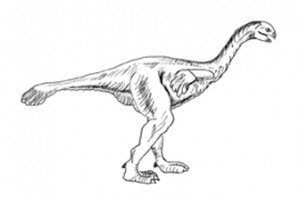New Chinese Dinosaur – Gigantoraptor
New Chinese Dinosaur – Introducing Gigantoraptor as tall as a Giraffe
Is it a bird, is it a plane, is it Superman..? no not quite; Dinosaurs are proving to be very surprising and the latest dinosaur to be described from China is no exception, as it may have resembled a gigantic bird, perhaps with feathers and most definitely with a short stumpy tail and a toothless beak.
Palaeontologists from Beijing’s Institute of Vertebrate Palaeontology and Palaeoanthropology (IVPP) under the direction of Xing Xu have described a new giant Oviraptor-like dinosaur from the late Cretaceous. To date Oviraptors had been thought of being relatively small, no bigger than 3 metres, but Gigantoraptor would have weighed 1,400 kilgrams and stood over 5 metres tall.
Gigantoraptor erlianensis
This new dinosaur has been named Gigantoraptor erlianensis, (meaning giant bird from the Erlian province), the fossils were discovered by an IVPP expedition to the Erlian basin in north-central China. Over the last 30 years or so, teams of scientists from IVPP (often working closely with the Royal Tyrrell museum from Canada), have explored these remote areas of China, with dozens and dozens of new dinosaurs being found. The IVPP is rapidly building up the largest fossil vertebrate collection in the world with over 200,000 specimens, many the holotype or reference specimens for dinosaurs.
The fossil Gigantoraptor is not complete but limb bones and the all important beak indicate that it was a member of the Oviraptorosauria, a group of strange-looking theropod dinosaurs from the late Cretaceous. Up until now Oviraptors were depicted as being speedy, light-weight opportunists and good parents as fossils unearthed in the 1990s showed Oviraptor brooding its eggs in a nest – just like a bird. The discovery of Gigantoraptor throws our understanding of this bizarre group into chaos, as this animal was big enough to look Tyrannosaurus rex in the eye.
Picture credit: Everything Dinosaur
The drawing above is based on a Gigantoraptor dinosaur model.
Was this Dinosaur Feathered?
Scientists have already begun speculating whether Gigantoraptor was feathered. Certainly, Oviraptors are normally depicted with feathers, as it is thought that warm-blooded, small dinosaurs would have needed feathers to keep them warm. Perhaps the young (or should I call them chicks?) of Gigantoraptor had feathers until they grew big enough not to have to worry about losing body heat too much.
The area where Gigantoraptor lived was very dry and arid. Palaeontologists are still unsure what Oviraptors ate. The beak, although toothless could be closed with tremendous force, in Gigantoraptor’s case the beak would have been powerful to have crushed seeds and nuts from the rapidly expanding flowering plants species. However, such a large and powerful beak would also have been able to crush bones, so perhaps Gigantoraptor was a carnivore, chasing down prey with its long legs. Everything Dinosaur team members are only aware of one model of Gigantoraptor.
A number of Oviraptor specimens show traits in their skeletons that link them closely to the evolution of birds. The femur (thighbone) of Gigantoraptor is very bird like, but much more sturdy (and many more fossils need to be found) before scientists can truly unravel the evolution of birds from theropod dinosaurs.
If Gigantoraptor does turn out to be feathered, it would be the biggest feathered animal yet discovered, dwarfing other Oviraptors and making “Big Bird” from Sesame Street look like a canary.
CollectA have introduced several feathered dinosaur figures, including a Gigantoraptor into their model range: CollectA Prehistoric Life Figures.


